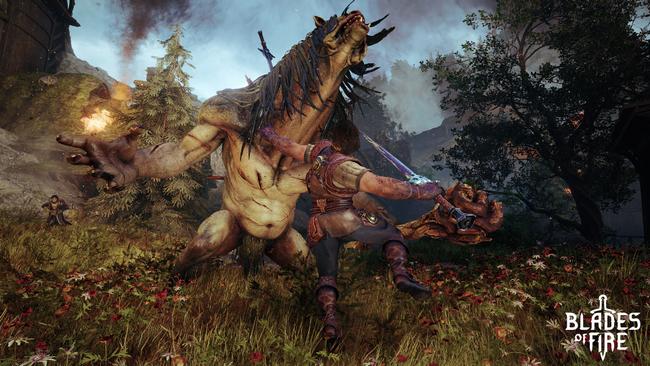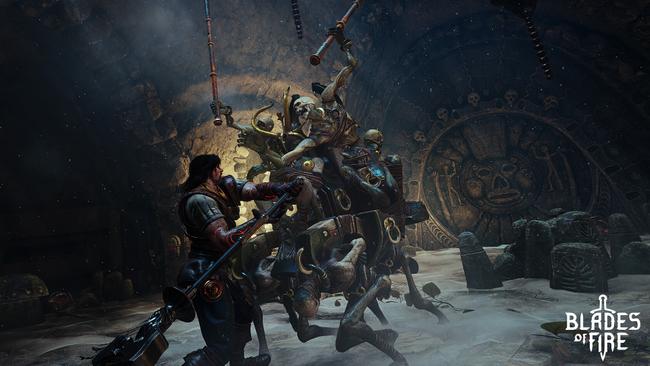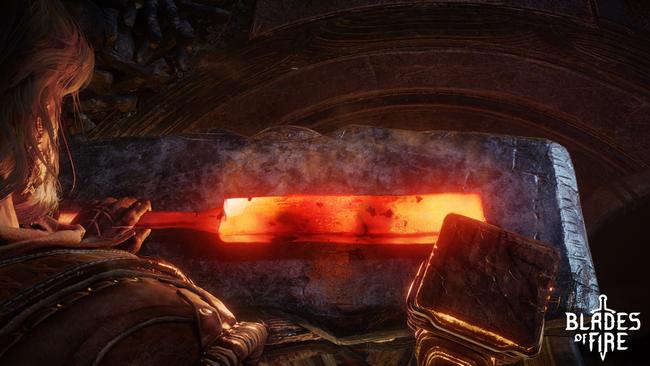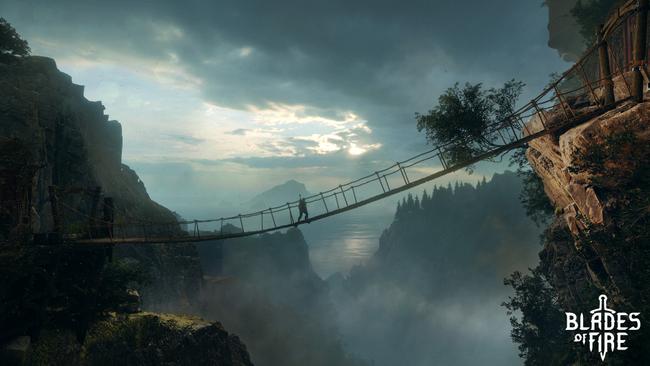
Blades of Fire Review
When I first wrote about Blades of Fire around GDC, I came away interested in seeing how the full game stacked up the short segment I played. The combination of the weapon crafting system, exploration and combat focusing on both where you strike an enemy and with what attribute of attack held a lot of promise; and now that I've had the chance to play the full game, on paper Blades of Fire is one of the most ambitious and fascinating games that the team has created. Maybe too ambitious, however.
Normally I wouldn't do this - but I'd like to take a moment to show behind the curtain, so to speak. This might or might not come as a surprise; but games media talk. Sometimes when review goes out, we'll ask each other how we're feeling about a game. If it has multiplayer, we'll try to schedule a session so we can all get a feel for how it works. For Blades of Fire, the conversation has consistently been something different - frustration at exploration and how to proceed during several key moments in the story.

Blades of Fire is an Action game with RPG elements, but at the same time it very much can feel like a metroidvania. While it's not an open-world game, each of the game's maps are incredibly vertical, with winding paths. From the very beginning the game makes it clear that they want players to explore on their own - and while that's all well and good in a vacuum, a combination of a woefully insufficient map, frustrating level design and more puts a damper on any enjoyment I found. Blades of Fire's world is beautiful, but it's also incredibly visually busy.
To make matters worse, things can be inconsistent when the game will highlight that something is interactable - one gameplay session has players have to wait for a ghostly companion to speak up and highlight something you need to interact with to progress. Another has you follow a skeleton child - but at a certain point he'll stop guiding you along, and it's up to you to figure out the way forward while dodging other enemies that look to abduct him from you. While this specific issue does dissipate as the game progresses, I wouldn't say that the game ever stops being frustrating to some extent.

By far the game's biggest strength revolves around weapon crafting. As you defeat enemies, you'll slowly learn how to craft the weapons they hold - and slowly you'll discover new metals and woods with their own defensive and offensive properties that can be used in crafting. Bringing different classes of weapons to a statue carrying a similar weapon will unlock new parts for weapons, too. You can impact a weapons range, it's penetration for slashing and piercing damage, and even how much durability it has - and how much durability it costs to sharpen it. Using a weapon will slowly whittle down its penetration, meaning you'll deal less and less damage and eventually won't be able to damage certain enemies at all; so it's a balancing act when deciding a weapon's durability versus its offense, among other stats.
Combat itself revolves around using the face buttons. When you lock-on to an enemy, an outline will showcase how your weapon's current mode of attack will handle attacking different body parts. A green outline means you meet the penetration to deal damage when targeting that body part. Yellow means it's borderline, while red indicates that an attack will bounce without dealing any damage. Different enemies will have different penetration thresholds for slashing and piercing attacks, so if your sword won't do the job against a specific enemy - maybe a spear will manage. Each strike uses stamina, and the less stamina available to you the slower your attacks - holding down the guard button will replenish stamina, while timing a block at the right time will parry an attack, giving you unlimited stamina for a short period.

While a lumbering affair, combat feels a lot more considered than many of the action games I've played in recent years. Since you can aim a weapon, sometimes the environment itself is a consideration - if you're in a tight corridor, you'll either want to swing for an enemy's legs to avoid clipping a wall, or switch to a piercing stance if possible. Maybe you can kite an enemy around a corner and use a sweeping attack to hit them without putting yourself in range of their retaliation.
At the best of times, when the game's level design is a boon and not a hindrance, you can see the bones of how Blades of Fire can be something truly special. Even the story has its shining moments, as understated as it is. Yet at the end of the day the level design rears its ugly head. When forging weapons, depending on how efficiently you handle the process you can unlock a number of repairs for the weapon. These repairs, however, require a number of the same resources that you used to craft it in the first place.
This presents a problem; while on the map you're told which material is common for an area, there's no way to specifically mark where to get it. As a band-aid, as you use weapons they gain fame; you can trade-in spent weapons to Glinda, who will give you the option to select any one material to trade for. While this is all well and good, and means that you can trade in a bunch of spent weaker weapons for the materials to craft a god-tier weapon, this means that you're constantly going to want to use weapons that might not be the best fit for the job so you'll be able to repair or craft better weapons later on. While on paper this is fine, in practice it's just an extra frustration that feels like it doesn't add much to the game in the end, and directly gets in the way of player expression when weapon crafting.

All told, Blades of Fire is a mixed bag. I by and large enjoyed my time with it, warts and all - but I'd be hard-pressed to recommend the game in its current state. Worse, without some heavy retooling of the map I don't know if I ever could recommend the game at all without significant caveats. On the bright side, the game's PC port is rather good with a notably good HDR implementation. It's even playable on Steam Deck, if you can bother to get the Epic Games Store running on yours. I definitely appreciate any game that doesn't have traversal or shader compilation stutters these days, and from a technical standpoint MercurySteam has delivered a very good experience.
In an already packed year, Blades of Fire does its best to stand out - but it's hard to recommend with so many other games dropping at the same time, and the Switch 2 releasing in just a few short weeks. RPG fans have plenty to look forward to; maybe in a few months Blades of Fire will warrant a second look, but for now it's merely an interesting curiosity mired in some unfortunate frustrations.